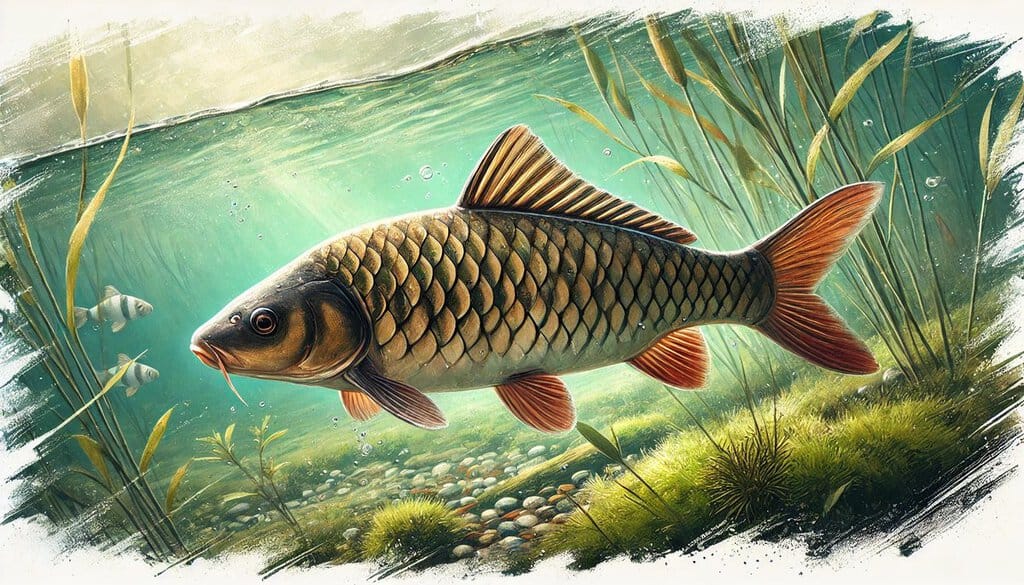Grass Carp (Ctenopharyngodon idella) is a popular species in aquaponics due to its rapid growth rate, adaptability, and efficiency in controlling aquatic vegetation[1]. This herbivorous fish is known for its voracious appetite for aquatic plants, making it an excellent choice for systems where plant control is desired alongside fish production.
Natural Habitat and Behavior
Origin and native environment: Grass Carp are native to eastern Asia, particularly the rivers of China and Russia[1]. They naturally inhabit large rivers and lakes.
Natural behavior in the wild: In their natural habitat, Grass Carp are known for their schooling behavior and their tendency to feed on aquatic vegetation[1].
Temperament: Generally docile, Grass Carp are not aggressive towards other fish species[1].
Compatibility: They can be kept with other non-aggressive fish species in aquaponics systems.
Water Requirements
Temperature Range:
- Ideal temperature: 20-30°C (68-86°F)[1].
- Temperatures outside this range can stress the fish and reduce feeding and growth rates.
pH Level:
- Optimal pH range: 6.5-9.0[1].
- Grass Carp are relatively tolerant to pH fluctuations.
Water hardness:
- Prefer moderately hard water, but can tolerate a wide range of hardness levels.
Oxygen Levels:
- Require well-oxygenated water, ideally above 5 mg/L[1].
- Can tolerate lower oxygen levels temporarily but may experience stress.
Ammonia/Nitrate Sensitivity:
- Sensitive to high ammonia and nitrite levels.
- Maintain ammonia below 0.05 mg/L and nitrite below 0.1 mg/L[1].
Tank or Pond Setup
Tank/Pond Size:
- Minimum 1000 liters (264 gallons) per adult fish[1]. (in ponds I imagine)
- Density should not exceed 1 fish per 2-3 m² (21.5-32.3 ft²) of surface area in ponds.
- In an Aquaponics system the density should be more or less like any other carp, higher than ponds as airation, filtration and food availability is better.
Filtration & Aeration:
- Require good filtration and aeration due to their size and waste production[1].
Lighting Considerations:
- No specific lighting requirements, but natural light cycles are beneficial.
Tank Decorations/Substrate:
- Prefer open swimming areas with some aquatic vegetation for grazing[1].
- Do not put these fish in DWC/floating raft systems as they will eat your plants roots.
Feeding Requirements
Diet:
- Primarily herbivorous, consuming aquatic plants and algae[1].
- In aquaponics, can be supplemented with commercial pelleted feed.
Feeding Techniques:
- Feed 2-3 times daily.
- Will consume excess plant matter in the system, aiding in nutrient cycling.
Supplements or special diets:
- May require vitamin supplementation if plant matter is limited.
Growth and Reproduction
Growth Rate:
- Can grow up to 1 kg (2.2 lbs) per year under optimal conditions[1].
- Reach maturity at 2-3 years of age.
Physical Growth Indicators:
- Develop elongated bodies and large scales as they mature.
Breeding Behavior:
- Breeding in captivity is challenging and typically not attempted in aquaponics systems[1].
Harvesting & Culinary Considerations
Growth to Harvest:
- Can be harvested at 1-2 kg (2.2-4.4 lbs), typically after 1-2 years of growth[1].
Culinary Uses:
- Mild-flavored white flesh, suitable for various cooking methods.
Pros and Cons
- Efficient at controlling aquatic vegetation.
- Rapid growth rate.
- Adaptable to various water conditions.
- May consume desirable plants in the system.
- They require large spaces due to their size.
- Will eat plant roots if placed in DWC/floating raft system
Overall Suitability:
- Best for experienced aquaponics practitioners with large systems.
Common Health Issues and Solutions
Potential Diseases:
- Susceptible to bacterial and parasitic infections common in freshwater fish[1].
Signs of Health Issues:
- Reduced appetite, abnormal swimming behavior, visible lesions.
Treatment Recommendations:
- Maintain water quality and quarantine new fish to prevent disease introduction[1].
Maintenance Tips for Long-Term Health
Maintenance Frequency: Regular water quality testing and system checks.
System checks: Monitor temperature, pH, and dissolved oxygen levels regularly.
Handling Practices: Minimize handling to reduce stress.
Winter/Summer Care: Provide temperature control during extreme seasons.
Closing Thoughts
Grass Carp can be an excellent choice for large-scale aquaponics systems, particularly where aquatic plant control is desired. However, their size and specific requirements make them more suitable for experienced practitioners with ample space and resources.
More fish species for aquaponics
Additional Resources/References
[1] FAO Fisheries & Aquaculture – Cultured Aquatic Species Information Programme – Ctenopharyngodon idellus (Valenciennes, 1844). https://www.fao.org/fishery/en/culturedspecies/ctenopharyngodon_idellus/en
External sources:
[1] https://edis.ifas.ufl.edu/publication/IN1038
[2] https://nas.er.usgs.gov/queries/FactSheet.aspx?speciesID=514
[3] https://www.mdpi.com/2073-4441/15/9/1771
[4] https://www.sciencedirect.com/science/article/pii/S2352513422002630
[5] https://www.sciencedirect.com/science/article/pii/S2772735123000884
[6] https://www.fao.org/fishery/docs/CDrom/aquaculture/I1129m/file/en/en_grasscarp.htm
[7] https://invasivecarp.us/GrassCarp.html

